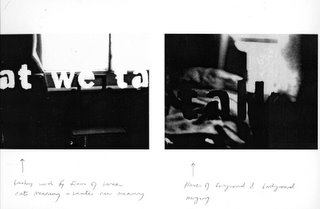Project Premise
This project is my chance to push the idea of 'suspense' into a less predictable territory. My intention is to start with a source story that creates suspense through a slow and precise buildup of human interaction - and subsequently build a visual language that creates suspense more subtly.
My starting point is Raymond Carver's short story, "What We Talk About When We Talk About Love" - a beautiful example of his writing style. Carver's writing is straightforward, stark and destitute of sentimentality. Language is pared down to the absolute minimum - narrative flow and characterisation is controlled precisely. Carver cites Isaac Babel's dictum, "No iron can pierce the heart with such force as a period put in just the right place,"
He also spoke about how he approaches words and how he used them in his poetry and short stories:
"For me, Hemingway's sentences are poetry. There's a rhythm, a cadence. I can reread his early stories and I find them as extraordinary as ever. They fire me up as much as ever. It's marvelous writing. He said prose is architecture and the Baroque age is over. That suits me. Flaubert said close to the same thing, that words are like stones with which one builds a wall. I believe that completely. I don't like careless writers whose words have no moorings, are too slippery."
TENSION
The suspense of Carver's short stories is derived from both his subject matter and writing style. This story, like many others, is centred around somewhat isolated people, often facing loss and terror in the mundane circumstances of their own lives.
Carver's prose is often muted, even anticlimactic, but the atmosphere is tense. In these ordinary, marginal and routine lives, the reader senses an underlying mystery. He subtly suggests a series of conflicts which create a subliminal tension in the reader, a tension tht culminates in the disturbing last lines of his stories. Some methods he uses to create tension in his narrative are:
- He creates an expectation and doesn't fulfil it
- He frustrates readers by having his stories end abruptly
- Subliminal conflicts/subtexts within main narrative
In "What We Talk About When We Talk About Love", the reader follows a very simple scenario - two couples sitting around talking anecdotally about love. Beneath this conversation - one senses a strange and never fully identified tension between these four characters, between couples. I have set the parameters of working with letterforms over black and white film. I have also isolated some visual metaphors that echo aspects of the story. These could operate as studies:
- character (type) seeming cohesive, natural, ordered - and gradually becoming isolated. Each character ends in total isolation in this story
- character operating on a surface level, while some undercurrent element subsumes the surface action.
- playing with filming letters/words; and then animating digitally on surface of film.
My starting point is Raymond Carver's short story, "What We Talk About When We Talk About Love" - a beautiful example of his writing style. Carver's writing is straightforward, stark and destitute of sentimentality. Language is pared down to the absolute minimum - narrative flow and characterisation is controlled precisely. Carver cites Isaac Babel's dictum, "No iron can pierce the heart with such force as a period put in just the right place,"
He also spoke about how he approaches words and how he used them in his poetry and short stories:
"For me, Hemingway's sentences are poetry. There's a rhythm, a cadence. I can reread his early stories and I find them as extraordinary as ever. They fire me up as much as ever. It's marvelous writing. He said prose is architecture and the Baroque age is over. That suits me. Flaubert said close to the same thing, that words are like stones with which one builds a wall. I believe that completely. I don't like careless writers whose words have no moorings, are too slippery."
TENSION
The suspense of Carver's short stories is derived from both his subject matter and writing style. This story, like many others, is centred around somewhat isolated people, often facing loss and terror in the mundane circumstances of their own lives.
Carver's prose is often muted, even anticlimactic, but the atmosphere is tense. In these ordinary, marginal and routine lives, the reader senses an underlying mystery. He subtly suggests a series of conflicts which create a subliminal tension in the reader, a tension tht culminates in the disturbing last lines of his stories. Some methods he uses to create tension in his narrative are:
- He creates an expectation and doesn't fulfil it
- He frustrates readers by having his stories end abruptly
- Subliminal conflicts/subtexts within main narrative
In "What We Talk About When We Talk About Love", the reader follows a very simple scenario - two couples sitting around talking anecdotally about love. Beneath this conversation - one senses a strange and never fully identified tension between these four characters, between couples. I have set the parameters of working with letterforms over black and white film. I have also isolated some visual metaphors that echo aspects of the story. These could operate as studies:
- character (type) seeming cohesive, natural, ordered - and gradually becoming isolated. Each character ends in total isolation in this story
- character operating on a surface level, while some undercurrent element subsumes the surface action.
- playing with filming letters/words; and then animating digitally on surface of film.











